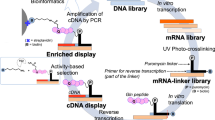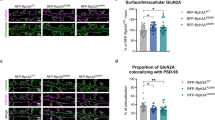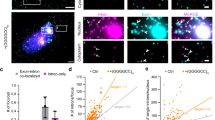Abstract
Protein isoforms with or without a single amino acid residue make a subtle difference. It has been documented on a few genes that alternative splicing generated such isoforms; however, the fact has attracted little attention. We became aware of a subtle sequence difference in DRPLA, a polyglutamine disease gene for dentatorubral pallidoluysian atrophy. Some reported cDNA sequences lacked 3 nucleotides (nt) (CAG), which were positioned apart from the expandable and polymorphic CAG repeats and also coded for glutamine. We experimentally confirmed that the difference was indeed generated by alternative splicing utilizing two acceptors separated by 3 nt. In DRPLA, the expression ratio of two mRNA isoforms was almost constant among tissues, with the CAG-included form being major. The glutamine-included protein isoform was more predominantly localized in the nucleus. Database searching revealed that alternative splice acceptors, as well as donors, are frequently situated very close to each other. We experimentally confirmed two mRNA isoforms of 3 nt difference in more than 200 cases by RT-PCR and found interesting features associated with this phenomena. Inclusion of 3 nt tends to result in single amino acid inclusion despite the phase of translational frame. The expression ratio sometimes varied extensively among tissues.
Similar content being viewed by others
Log in or create a free account to read this content
Gain free access to this article, as well as selected content from this journal and more on nature.com
or
References
Black DL (2003) Mechanisms of alternative pre-messenger RNA splicing. Annu Rev Biochem 72:291–336
Chua K, Reed R (2001) An upstream AG determines whether a downstream AG is selected during catalytic step II of splicing. Mol Cell Biol 21:1509–1514
Condorelli G, Bueno R, Smith RJ (1994) Two alternatively spliced forms of the human insulin-like growth factor I receptor have distinct biological activities and internalization kinetics. J Biol Chem 269:8510–8516
Cummings CJ, Zoghbi HY (2000) Trinucleotide repeats: mechanisms and pathophysiology. Annu Rev Genomics Hum Genet 1:281–328
Ellerby LM, Andrusiak RL, Wellington CL, Hackam AS, Propp SS, Wood JD, Sharp AH, Margolis RL, Ross CA, Salvesen GS, Hayden MR, Bredesen DE (1999) Cleavage of atrophin-1 at caspase site aspartic acid 109 modulates cytotoxicity. J Biol Chem 274:8730–8736
Forman MS, Trojanowski JQ, Lee VM (2004) Neurodegenerative diseases: a decade of discoveries paves the way for therapeutic breakthroughs. Nat Med 10:1055–1063
Hiller M, Huse K, Szafranski K, Jahn N, Hampe J, Schreiber S, Backofen R, Platzer M (2004) Widespread occurrence of alternative splicing at NAGNAG acceptors contributes to proteome plasticity. Nat Genet 36:1255–1257
Igarashi S, Koide R, Shimohata T, Yamada M, Hayashi Y, Takano H, Date H, Oyake M, Sato T, Sato A, Egawa S, Ikeuchi T, Tanaka H, Nakano R, Tanaka K, Hozumi I, Inuzuka T, Takahashi H, Tsuji S (1998) Suppression of aggregate formation and apoptosis by transglutaminase inhibitors in cells expressing truncated DRPLA protein with an expanded polyglutamine stretch. Nat Genet 18:111–117
International Human Genome Sequencing Consortium (2004) Finishing the euchromatic sequence of the human genome. Nature 431:931–945
Kanazawa I (1998) Dentatorubral-pallidoluysian atrophy or Naito-Oyanagi disease. Neurogenetics 2:1–17
Lallena MJ, Chalmers KJ, Llamazares S, Lamond AI, Valcarcel J (2002) Splicing regulation at the second catalytic step by Sex-lethal involves 3’ splice site recognition by SPF45. Cell 109:285–296
Lin MJ, Lee TL, Hsu DW, Shen CK (2000) One-codon alternative splicing of the CpG MTase Dnmt1 transcript in mouse somatic cells. FEBS Lett 469:101–104
Lopez AJ (1998) Alternative splicing of pre-mRNA: developmental consequences and mechanisms of regulation. Annu Rev Genet 32:279–305
Love SJ, Margolis RL, Young WS, Li SH, Schilling G, Ashworth RG, Ross CA (1995) Cloning and expression of the rat atrophin-I (DRPLA disease gene) homologue. Neurobiol Dis 2:129–138
Manrow RE, Berger SL (1993) GAG triplets as splice acceptors of last resort. An unusual form of alternative splicing in prothymosin alpha pre-mRNA. J Mol Biol 234:281–288
Margolis RL, Li SH, Young WS, Wagster MV, Stine OC, Kidwai AS, Ashworth RG, Ross CA (1996) DRPLA gene (atrophin-1) sequence and mRNA expression in human brain. Brain Res Mol Brain Res 36:219–226
Michalik A, Van Broeckhoven C (2003) Pathogenesis of polyglutamine disorders: aggregation revisited. Hum Mol Genet 12:R173–R186
Miki N, Ono M, Murata Y, Ohsaki E, Tamitsu K, Yamada M, Demura H (1996) Regulation of pituitary growth hormone-releasing factor (GRF) receptor gene expression by GRF. Biochem Biophys Res Commun 224:586–590
Miyahara A, Okamura-Oho Y, Miyashita T, Hoshika A, Yamada M (2003) Genomic structure and alternative splicing of the insulin receptor tyrosine kinase substrate of 53-kDa protein. J Hum Genet 48:410–414
Miyashita T, Okamura-Oho Y, Mito Y, Nagafuchi S, Yamada M (1997) Dentatorubral pallidoluysian atrophy (DRPLA) protein is cleaved by caspase-3 during apoptosis. J Biol Chem 272:29238–29242
Miyashita T, Nagao K, Ohmi K, Yanagisawa H, Okamura-Oho Y, Yamada M (1998) Intracellular aggregate formation of dentatorubral-pallidoluysian atrophy (DRPLA) protein with the extended polyglutamine. Biochem Biophys Res Commun 249:96–102
Miyashita T, Matsui J, Ohtsuka Y, U M, Fujishima S, Okamura-Oho Y, Inoue T, Yamada M (1999) Expression of extended polyglutamine sequentially activates initiator and effector caspases. Biochem Bhiophys Res Commun 257:724–730
Modrek B, Lee C (2002) A genomic view of alternative splicing. Nat Genet 30:13–19
Nagafuchi S, Yanagisawa H, Sato K, Shirayama T, Ohsaki E, Bundo M, Takeda T, Tadokoro K, Kondo I, Murayama N, Tanaka Y, Kikushima H, Umino K, Kurosawa H, Furukawa T, Nihei K, Inoue T, Sano A, Komure O, Takahashi M, Yoshizawa T, Kanazawa I, Yamada M (1994a) Dentatorubral and pallidoluysian atrophy expansion of an unstable CAG trinucleotide on chromosome 12p. Nat Genet 6:14–18
Nagafuchi S, Yanagisawa H, Ohsaki E, Shirayama T, Tadokoro K, Inoue T, Yamada M (1994b) Structure and expression of the gene responsible for the triplet repeat disorder, dentatorubral and pallidoluysian atrophy (DRPLA). Nat Genet 8:177–182
Nucifora FC Jr, Ellerby LM, Wellington CL, Wood JD, Herring WJ, Sawa A, Hayden MR, Dawson VL, Dawson TM, Ross CA (2003) Nuclear localization of a non-caspase truncation product of atrophin-1, with an expanded polyglutamine repeat, increases cellular toxicity. J Biol Chem 278:13047–13055
Oberkofler H, Beer A, Breban D, Hell E, Krempler F, Patsch W (1997) Human obese gene expression: alternative splicing of mRNA and relation to adipose tissue localization. Obes Surg 7:390–396
Okamura-Oho Y, Miyashita T, Ohmi K, Yamada M (1999) Dentatorubral-pallidoluysian atrophy protein interacts through a proline-rich region near polyglutamine with the SH3 domain of an insulin receptor tyrosine kinase substrate. Hum Mol Genet 8:947–957
Okamura-Oho Y, Miyashita T, Nagao K, Shima S, Ogata Y, Katada T, Nishina H, Yamada M (2003) Dentatorubral-pallidoluysian atrophy protein is phosphorylated by c-Jun NH2-terminal kinase. Hum Mol Genet 12:1535–1542
Onodera O, Oyake M, Takano H, Ikeuchi T, Igarashi S, Tsuji S (1995) Molecular cloning of a full-length cDNA for dentatorubral-pallidoluysian atrophy and regional expressions of the expanded alleles in the CNS. Am J Hum Genet 57:1050–1060
Ozaki M, Itoh K, Miyakawa Y, Kishida H, Hashikawa T (2004) Protein processing and releases of neuregulin-1 are regulated in an activity-dependent manner. Neurochem 91:176–188
Ross CA (1997) Intranuclear neuronal inclusions: a common pathogenic mechanism for glutamine-repeat neurodegenerative diseases? Neuron 19:1147–1150
Sorek R, Shamir R, Ast G (2004) How prevalent is functional alternative splicing in the human genome? Trends Genet 20:68–71
Tadokoro K, Oki N, Sakai A, Fujii H, Ohshima A, Nagafuchi S, Inoue T, Yamada M (1993) PCR detection of 9 polymorphisms in the WT1 gene. Hum Mol Genet 2:2205–2206
Thanaraj TA, Stamm S, Clark F, Riethoven JJ, Le Texier V, Muilu J (2004) ASD: the alternative splicing database. Nucleic Acids Res 32:D64–D69
U M, Miyashita T, Ohtsuka Y, Okamura-Oho Y, Shikama Y, Yamada M (2001) Extended polyglutamine selectively interacts with caspase-8 and −10 in nuclear aggregates. Cell Death Differ 8:377–386
Vogan KJ, Underhill DA, Gros P (1996) An alternative splicing event in the Pax-3 paired domain identifies the linker region as a key determinant of paired domain DNA-binding activity. Mol Cell Biol 16:6677–6686
Wu S, Romfo CM, Nilsen TW, Green MR (1999) Functional recognition of the 3’ splice site AG by the splicing factor U2AF35. Nature 402:832–835
Yanagisawa H, Bundo M, Miyashita T, Okamura-Oho Y, Tadokoro K, Tokunaga K, Yamada M (2000) Protein binding of a DRPLA family through arginine-glutamic acid dipeptide repeats is enhanced by extended polyglutamine. Hum Mol Genet 9:1433–1442
Acknowledgements
We thank A. Asaka for technical assistance and K. Saito for preparing the manuscript. This study was supported in part by Grants for Human Genome, for Paediatric Research from the Ministry of Health, Labour and Welfare, Japan.
Author information
Authors and Affiliations
Corresponding author
Rights and permissions
About this article
Cite this article
Tadokoro, K., Yamazaki-Inoue, M., Tachibana, M. et al. Frequent occurrence of protein isoforms with or without a single amino acid residue by subtle alternative splicing: the case of Gln in DRPLA affects subcellular localization of the products. J Hum Genet 50, 382–394 (2005). https://doi.org/10.1007/s10038-005-0261-9
Received:
Accepted:
Published:
Issue date:
DOI: https://doi.org/10.1007/s10038-005-0261-9
Keywords
This article is cited by
-
Nucleotides in both donor and acceptor splice sites are responsible for choice in NAGNAG tandem splice sites
Cellular and Molecular Life Sciences (2021)
-
Genome-wide analysis of alternative splicing divergences between Brassica hexaploid and its parents
Planta (2019)
-
Genome-wide study of NAGNAG alternative splicing in Arabidopsis
Planta (2014)
-
Arginine68 is an essential residue for the C-terminal cleavage of human Atg8 family proteins
BMC Cell Biology (2013)
-
Characterization of an alternative splicing by a NAGNAG splice acceptor site in the porcine KIT gene
Genes & Genomics (2011)



